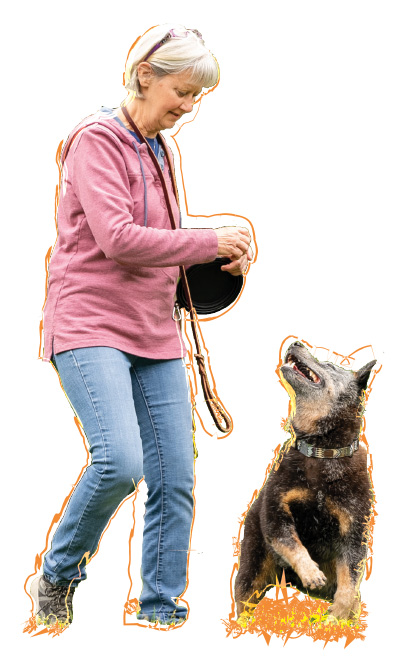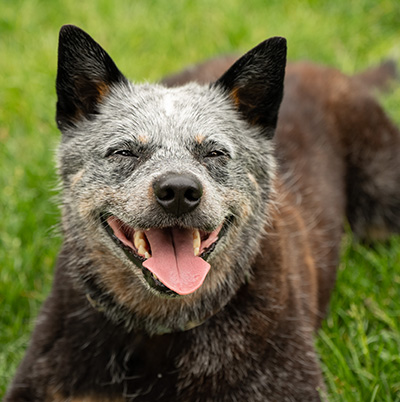

Though many people suggested Huck’s leg could not be saved, Gail Roderick was determined not to give up on her dog.

Roderick had been hiking a familiar trail near Grand Rapids, Michigan, when her 2-year-old Australian cattle dog, Huck, was struck in the shoulder by two bullets fired from an unseen hunting rifle some 20 feet away. She rushed him to a local veterinary clinic, where doctors stabilized him, but found that the wounds were too severe for them to repair.
The clinic contacted veterinary orthopedic centers across the state in search of a surgeon who could help Huck.
“All but one of them said his leg could not be saved,” says Roderick. “But this was unacceptable. When we called MSU, we talked to Dr. Loïc Déjardin, who said, ‘Please don’t amputate yet. We can fix this.’”
“Huck’s extensive wounds created some of the largest muscular defects that Dr. Déjardin had ever treated,” says Roderick. The bullets entered Huck’s right humerus and thoracic wall. Bullet fragments acted as secondary missiles that shattered the entire middle section of the humerus, leaving a large cavitation where muscles, nerves, and vessels had been destroyed.
“Huck had almost no neurological function,” explains Déjardin, who is head of the Orthopedic Surgery Service, “Fortunately, the radial nerve, which is essential for limb function, was not severed. Had the nerve been severed, the only option would have been amputation.”
In surgery, Déjardin placed an I-Loc interlocking nail implant in Huck’s fractured humerus. Developed by Déjardin and patented by MSU, the I-Loc is a thin, metal rod that is placed in the medullar cavity of a bone. Bolts lock the nail into place within the bone, which causes minimal disruption to surrounding soft tissues, allowing patients to heal faster.This implant also resists fracture forces very effectively, which was critical in Huck’s case, as about 35 percent of his humerus was missing. Such large deficits cannot heal on their own. To boost bone healing, Déjardin and his team used a large bone graft as well as antibiotic-impregnated calcium sulfate pellets to control infection. Due to the severity of the fracture and the small size of the lower bone segment, there was very little to anchor the nail to; a smaller-than-optimal nail would be necessary until bone formation would allow a larger nail to replace the original one.


Six weeks after the initial surgery, Déjardin placed an external skeletal fixator to further support the fracture, and four months after Huck’s injury, the fixator and the original nail could be replaced with the larger initially-planned I-Loc nail. After an additional nine weeks, the fracture was fully healed. The I-Loc implant was no longer needed.
Déjardin and his team continued to follow Huck’s progress; full consolidation, or “boney union,” was documented approximately one year after the original surgery. Huck could soon support himself confidently with his injured leg. Roderick says she “couldn’t believe it” the first time he casually strolled by, comfortably using all limbs as normal.
At home, Huck was carefully monitored by his family.
“We were so diligent and careful,” describes Roderick. Months of crate rest was no easy feat. As a competitor in show herding events and an avid frolicker on his family’s five-acre farm, Huck led an active lifestyle.
“How do you keep a cattle dog quiet? Firstly, Huck just seemed to get it,” she continues. “Whatever I ask of him, he just seems to understand: ‘This needs to be done,’ and he trusted me.”Huck also grew to trust the doctors, veterinary nurses, assistants, and clinical students at MSU. Weekly recheck and bandage change appointments meant that Huck came to see campus as a second home. Even today, he lights up when he arrives at the Hospital building.
“He was always happy to see everybody at MSU,” Roderick recalls. “And I could text his doctors any time I thought something was wrong. They always had us in immediately. I felt like there was a huge team as dedicated as I was to saving Huck’s leg.”
Today, Roderick says it’s as if Huck was never injured. He walks several miles a day, plays fetch, and swims and runs at his favorite beach in northern Michigan.
“I don’t take a single day with Huck for granted,” says Roderick. “We end every day with Huck asleep in my lap. Sometimes when Huck is running through the woods full tilt, jumping over logs, turning on a dime,
I just watch and lose myself in his revelry. I have my wonderful Huck back and we will make the most of every new day.” 